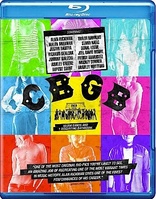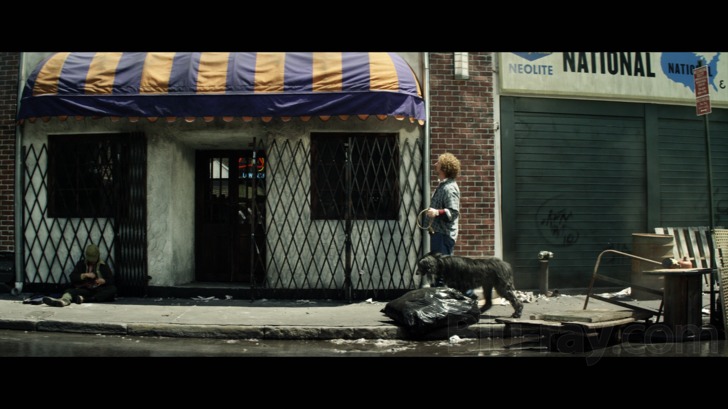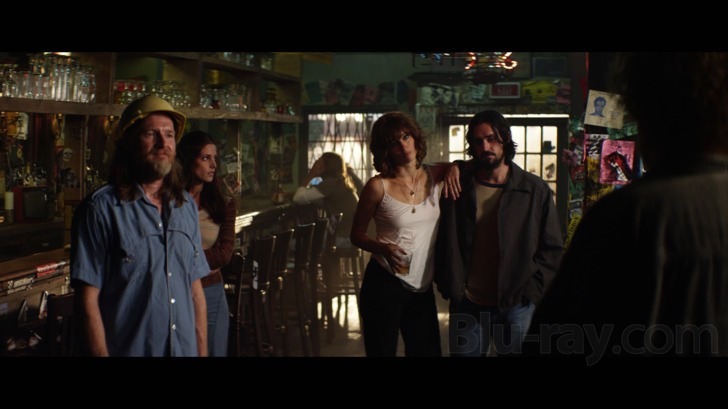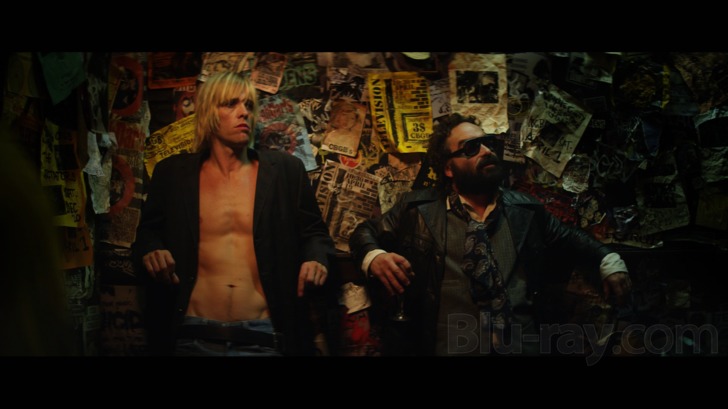CBGB Blu-ray Movie
HomeCBGB Blu-ray Movie 
XLrator | 2013 | 103 min | Rated R | Dec 31, 2013
Movie rating
6.4 | / 10 |
Blu-ray rating
| Users | 0.0 | |
| Reviewer | 2.5 | |
| Overall | 2.5 |
Overview
CBGB (2013)
The story of Hilly Kristal's New York club from its creation as an unlikely venue for Country, Bluegrass and Blues (CBGB) to what it ultimately became: a haven for new bands and a landmark in the history of punk, alternative rock and underground music.
Starring: Alan Rickman, Malin Akerman, Freddy Rodriguez, Stana Katic, Richard de KlerkDirector: Randall Miller
| Music | Uncertain |
| Drama | Uncertain |
| History | Uncertain |
Specifications
Video
Video codec: MPEG-4 AVC
Video resolution: 1080p
Aspect ratio: 2.39:1
Original aspect ratio: 2.39:1
Audio
English: DTS-HD Master Audio 5.1 (48kHz, 24-bit)
Subtitles
English SDH
Discs
25GB Blu-ray Disc
Single disc (1 BD)
Playback
Region A (B, C untested)
Review
Rating summary
| Movie | 1.5 | |
| Video | 4.0 | |
| Audio | 3.5 | |
| Extras | 2.5 | |
| Overall | 2.5 |
CBGB Blu-ray Movie Review
Heebie Jeebies—OMFG!
Reviewed by Michael Reuben December 31, 2013The club known as "CBGB" was founded in 1973 in lower Manhattan and managed to survive until 2006. Although its founder, the late Hilly Kristal, dreamed of creating a venue for Country, BlueGrass and Blues (hence the name), almost none of the 50,000 bands that performed on CBGB's tiny stage fit that description. CBGB is best known for hosting bands like Blondie, The Ramones, Patti Smith, Mink DeVille, The Cramps and, in their early days, The Police. Talking Heads famously got their start at Hilly Kristal's club, because they lived across the street. Kristal quickly realized that his creation has taken on its own life and added a subtitle to the name: OMFUG, which stood for "Other Music For Uplifting Gormandizers". There's a great movie (probably more than one) to be made about CBGB, but the depressing caricature created by the husband-and-wife team of Randall Miller and Jody Savin isn't it. Despite input from Hilly Kristal's daughter, Lisa, and access to numerous authentic props and artifacts, Miller's and Savin's low-rent bio-pic doesn't contain one second of authentic feeling for Kristal's club or the musical personalities that kept it vital and exciting for decades—not just the big names, but the hopefuls who didn't make it, for one reason or another. The savagery of many of the negative reviews can be attributed to a sense of personal betrayal by writers who felt that their memories of a cultural shrine had been desecrated. Even some who haven't even seen the film have expressed outrage at its claim to tell the history of "punk", of which Kristal's club was certainly a part but in no way the whole. The real problem is that Miller and Savin have no feeling for the material. They may have recreated CBGB using original walls, artwork and even the toilets from the famously filthy bathroom, and they throw a few Seventies items into the frame (like President Nixon on TV declaring "I'm not a crook" or the famous Daily News headline: "Ford To City: Drop Dead"), but that doesn't mean they have any understanding of Hilly Kristal, his era or the phenomenon that CBGB's became. And casting a bevy of talented actors to imitate famous and not-so-famous musicians as they lip-sync to their songs does nothing to explain what made their music popular and transformative. In Miller's and Savin's hands, figures like The Ramones and Blondie become additions to the clown car that was Hilly Kristal's circus. They treat a major chapter of cultural history as if they were making an American Pie movie.

The movie opens with Hilly Kristal concluding his second bankruptcy after the failure of a bar, also his second. The judge suggests he try another type of business. With his long-time sidekick, Merv Ferguson (Donal Logue), who always wore a hardhat, Hilly goes to his mother (Seinfeld's Estelle Harris) to cadge yet another loan to open a bluegrass club in a derelict neighborhood on the Lower East Side. The word "derelict" applies literally. One of the first people Hilly encounters outside the space is a junkie known as "Idaho" (Freddy Rodriguez), who becomes CBGB's chef and general gofer. The alley behind the bar is strewn with vagrants, trash and the occasional dead body, and Hilly's initial clientele are a biker gang with whom he makes friends by giving them free beer. (They abandon the place when the bluegrass music fails to materialize.) Now, right from the outset, CBGB is in trouble, because its central character is miscast. Hilly Kristal was a familiar New York Jewish character, born and raised in New Jersey, perpetually downtrodden, moody and morose (at least in 1973, when he was broke and a failure), but determined to make something of himself, if for no other reason than to impress his disapproving mother. He also had an unpredictable streak of generosity that made him a generous mensch to starving musicians, while his own bills went unpaid. So whom do Miller and Savin cast to play this quintessentially American impresario? Why, obviously, Professor Snape himself, Alan Rickman, with whom they'd previously made Bottle Shock and Nobel Son. Now, Rickman is an accomplished actor, but he clearly has no grasp on this particular character, and he isn't helped by a script that offers him nothing more to express Kristal's musical instincts than leaning forward while listening to a band and uttering the phrase, "There's something there." For the rest, all he can do is mope around, hang up on creditors and snap at anyone who tries to talk financial sense to him, including Merv and his daughter Lisa (Ashley Greene). Miller spends far too much of CBGB dwelling on the squalor of the club's surroundings: the makeshift stage, the "pretend" chili (for which the secret ingredient is ketchup), the rats and roaches, the ancient electrical system, the fleas and poop from Hilly's uncontrollable dog that drive his sound engineer, Taxi (Richard de Klerk), to distraction. Eventually, though, the club takes off, and Miller gets around to a kind of "greatest hits" rendition of CBGBs early years, featuring an impressive cast of look-a-likes. But while the parade of imitators are enough to spawn a K-Tel-style CD, none of them conveys any sense of musical vitality. Miller and Savin prefer to play them for pratfalls and R-rated jokes. The Ramones behave like the Three Stooges. The Dead Boys (the group that Hilly managed during its brief lifespan) are permanently intoxicated lunatics. Blondie's most memorable scene is when the stage collapses while they're playing, and lead singer Debbie Harry's biggest moments are to declare "I like sex" and be upstaged by Iggy Pop (Taylor Hawkins), who grabs the microphone from her to perform one of his own songs. Iggy, in turn, makes his most lasting impression when he's offered a blow job by The Dead Boys' manager (Johnny Galecki, almost unrecognizable). Lou Reed (Kyle Gallner) flashes by so quickly that he's little more than a dropped name who appears on the cover of the first issue of Punk Magazine. Patti Smith is portrayed as a weirdo who insists on reading poetry to a booing crowd that came to hear music; by all accounts, this actually happened, but it's presented without meaningful context. Even the acts that are treated with relative respect fail to register. The actors who impersonate Talking Heads or The Police are more animated than figures at Madame Tussaud's, but the effect is the same. Since they're not actually performing "Psycho Killer" or "Roxanne", the songs have to do all the work, and the songs are the same familiar recordings. The film has nothing to add. Nor is the movie salvaged by the constant use of comic book panels lifted drawn by John Holmstrom to mimic his work for Punk Magazine. (Holmstrom himself is played by Josh Zuckerman.) The device quickly becomes repetitive, and other than having Holmstrom show up at CBGB, the connection between him, the club and punk is never explored in any depth. Then again, what can one expect from a film that opens by claiming punk was "born" in Holmstrom's basement, as if a magazine created the music, rather than the other way around? CBGB ultimately exposes its own emptiness when, over the credit sequence, Miller and Savin run the actual footage from Talking Heads' induction into the Rock and Roll Hall of Fame in 2002, when they invited Hilly Kristal onto the stage to thank him. There's no sense of connection between the man who appears on the screen, or the remarks made about him by the band members, and the sulky deadbeat whom Alan Rickman has been struggling to play in a curly wig for the last 100 minutes. That guy lives in another world. Maybe "there's something there", but whatever it is, Miller and Savin can keep it.
CBGB Blu-ray Movie, Video Quality 

CBGB was shot by director Miller's long-time cinematographer, Mike Ozier. Specific information about the shooting format wasn't available, but the movie has a distinctly digital look, and not in a good way. I am not the first reviewer to observe inconsistency in CBGB's appearance, often varying from shot to shot, between a digitally grainy look that may be an attempt to suggest the grungy past and a clean, sharp style that would be suitable for any of today's high-end TV shows. Listening to the commentary, I got the distinct impression that the variance depended on where the shots were acquired, with the grainier ones originating in New York and the rest in Georgia, as if a decision was made to change shooting styles between the two locations. If so, even post-production on a digital intermediate couldn't eliminate the difference. XLrator's 1080p, AVC-encoded Blu-ray was presumably sourced from digital files and, to that extent, should be deemed an accurate representation of Miller's and Ozier's intended look. Except for the aforementioned grainy shots, the image is generally clean, sharp, detailed and colorful. The average bitrate of 20.97 Mbps is somewhat on the low side, but since there doesn't appear to be any film grain to compress, and the digitally grainy shots are relatively few, no artifacts seem to have resulted. Overall, the Blu-ray image is more than acceptable. It just needs a much better movie to represent.
CBGB Blu-ray Movie, Audio Quality 

CBGB's DTS-HD MA 5.1 soundtrack is perfectly adequate, reproducing the dialogue with clarity and the sounds of Hilly Kristal's bar, both crowded and empty, with enough detail to be convincing, if not particularly overwhelming. A truly adventurous sound mix would plunge the viewer, at least occasionally, into the middle of the crowded club when a band was playing at full volume so that, at least for a brief time, one might feel the claustrophobic excitement of a live performance, but the makers of CBGB harbor no such ambition. The film has no original score, but relies on songs by Blondie, Talking Heads, Television, The Dead Boys, The Ramones and many more, both in "live" performance and as background.
CBGB Blu-ray Movie, Special Features and Extras 

- Commentary with Co-Writer/Director Randall Miller, Co-Writer/Producer Jody Savin and Producer Brad Rosenberger: Miller speaks the most, followed closely by Savin, with Rosenberger a distant third. They focus almost exclusively on the logistics of each shot, pointing out which were done in New York City (very few, as it turns out), and which were done on sets constructed in Georgia or locations carefully dressed to simulate New York in the Seventies. They also discuss casting the supporting roles, but they never touch on the central question of why they cast Rickman as Hilly Kristal, as if that were never an issue. The commentary feels much like the movie: "Weren't these people at CBGB's wild 'n' crazy?" Even Savin thinks Miller is too preoccupied with dog poop.
- Outtakes (1080p; 2:39:1; 2:59): This is a small collection of shots referenced in the commentary. They include (a) comparisons of Freddy Rodriguez's Idaho character before and after CGI alteration of his teeth; (b) Estelle Harris doing multiple takes; and (c) various simulations of Hilly's dog pooping (as if the film didn't already have enough).
- Deleted Scenes (1080p; 2.39:1): A "play all" option is included.
- Hilly Is Pissed at Dead Boys, Has It Out with Merv (2:03)
- Cheetah Flips the Bird! (0:33)
- Trailers: The film's trailer is not included. At startup, the disc plays trailers for Banshee Chapter, Holy Ghost People and The Conspiracy . These can be skipped with the chapter forward button and are not otherwise available once the disc loads.
CBGB Blu-ray Movie, Overall Score and Recommendation 

If Alex Cox hadn't already made Sid and Nancy, he might have been the right director to tell the story of Hilly Kristal and CBGB. Or perhaps it could have been done by Julian Schnabel, whose bio-pic of Jean-Michel Basquiat demonstrated a special talent for conveying both a specific period and the sense of an artistic movement. There are undoubtedly dozens of unknown writer/directors out there with the skill and passion to tell this story properly. Let's hope that the existence of CBGB doesn't dissuade them. Rent if you must, but don't blame me if you want your time back.
Similar titles
Similar titles you might also like

Hearts Beat Loud
2018

El Cantante
2006

Ricki and the Flash
2015

Duets
2000

That Thing You Do!
1996

Soul Men
2008

Taking Woodstock
2009

The Upside
2017

Winter Passing
2005

Grace Unplugged
2013

Infinitely Polar Bear
2014

Juliet, Naked
2018

Walk Hard: The Dewey Cox Story
2-Disc Unrated Edition
2007

Popstar: Never Stop Never Stopping
2016

Rhinestone
1984

CB4: The Movie
1993

Notorious
Unrated Director's Cut Collector's Edition
2009

Swing Kids
1993

54
The Director's Cut
1998

8 Mile 4K
20th Anniversary Edition
2002